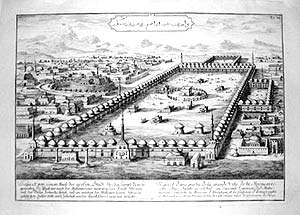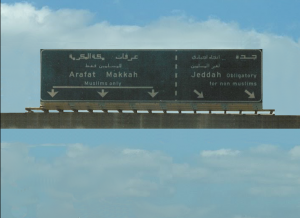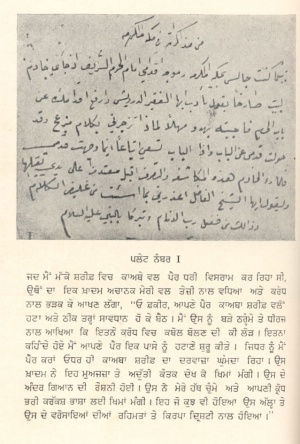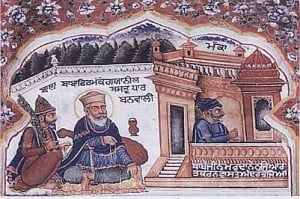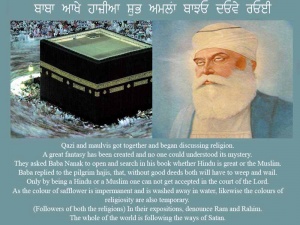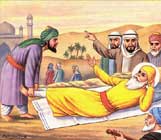Guru Nanak in Mecca
Guru Nanak went to Mecca on his 4th (last) udassi (journey/travel). Bhai Mardana went with him and he put on a blue dress worn by hajjis or Muhammadens who went on pilgrimage in those times, with him he took a Faqirs staff in his hand a collection of his hymns under his arm, with a jug(lota) for ablutions, thus he was in the guise of a hajji. Guru Nanak had now been on his Udasis (travels) for at least twenty years, since his sudden disappearance (around 1497) which had alarmed his followers and given some who were jealous of his growing influence to start all sorts of mischief, even accusing him of being a thief and stealing from Daulat Khan's stores.
During that time he had visited most of India going to the east as far as Assam and Burma; to the South as far as Sri Lanka (known also as Ceylon and Saran Deep) and to the north he had even crossed the Himalayas visiting Tibet and China. He and his tireless companions had travelled on foot and lived off the land and the generosity of others, Many of whom had become his followers. What a tireless traveller he was!
Historical Evidences
- Main article: Historicity of Guru Nanak travels to Mecca
Following are Sikh and Non Sikh historical books and manuscripts which serve as evidence of Nanak visited to Mecca:
- Siyatho Baba Nanak Shah Fakhir - By Haaji Taajudin Naqshbandhi: He met Guru nanak in Iran; while he was on Hajj pilgrimage. He recorded his travels in his manuscript.[1]
- Twarikh Arab - By Khwaja Jain-u-Labdeen: He was present in Mecca during Nanak's travel. He mentioned the discourse of Nanak and Rukn-ud-din.
- History of Punjab - Sayyed Muhammad Latif: He acknowledged Nanak travel to mecca.
- History of the Sikhs - Hari Ram Gupta; who mentioned Nanak dressed as Haji and went to Mecca.
- Vaar Bhai Gurdas - 16th Century menuscript by Gurdas, a writer, mentioned Nanak visited to Mecca
- Sau Sakhi - Manuscript regarded by Namdharis, Sect of Sikhs also mentioned two sections called Karni Nama and Raj Nama mentioning Nanak travels to Mecca.
- Janamsakhis - Early Sikh manuscripts; All Janamsakhis by different writers mentioned Nanak visit to Mecca
Non Muslims to Mecca
It is often argued that Guru Nanak could not travel Mecca and quotation from Quran are given in support of same:
Quran - Surah Tauba
- In Holy Quran it's mentioned in Surah Tauba like 9:28:
[Taubah 9:28] O People who Believe! The polytheists are utterly filthy *; so after this year do not let them come near the Sacred Mosque; and if you fear poverty **, then Allah will soon make you wealthy with His grace, if He wills; indeed Allah is All Knowing, Wise.
Oh you who believe! Truly the idolaters are unclean; so let them not, after this year, approach the Sacred Mosque(9:28).
Surah-Tauba is not against Nanak
It is argued Guru Nanak is a Muslim for entering the City of Mecca. Guru Nanak was strict Monotheist and believer in Tawhid i.e doctrine of "the oneness" of almighty. Surah Tauba is not against the path which Nanak follows. Guru Nanak was one who received divine revelation, which contains definition of a Muslim:
| ਮੁਸਲਮਾਣੁ ਕਹਾਵਣੁ ਮੁਸਕਲੁ ਜਾ ਹੋਇ ਤਾ ਮੁਸਲਮਾਣੁ ਕਹਾਵੈ ॥ ਅਵਲਿ ਅਉਲਿ ਦੀਨੁ ਕਰਿ ਮਿਠਾ ਮਸਕਲ ਮਾਨਾ ਮਾਲੁ ਮੁਸਾਵੈ ॥ ਹੋਇ ਮੁਸਲਿਮੁ ਦੀਨ ਮੁਹਾਣੈ ਮਰਣ ਜੀਵਣ ਕਾ ਭਰਮੁ ਚੁਕਾਵੈ ॥ |
| Musalmāṇ kahāvaṇ muskal jā ho▫e ṯā musalmāṇ kahāvai. Aval a▫ul ḏīn kar miṯẖā maskal mānā māl musāvai. Ho▫e muslim ḏīn muhāṇai maraṇ jīvaṇ kā bẖaram cẖukẖāvai. |
| It is difficult to be called a Muslim; if one is truly a Muslim, then he may be called one. First, let him savor the religion of the Prophet as sweet; then, let his pride of his possessions be scraped away. Becoming a true Muslim, a disciple of the faith of Mohammed, let him put aside the delusion of death and life. As he submits to God's Will, and surrenders to the Creator, he is rid of selfishness and conceit. And when, O Nanak, he is merciful to all beings, only then shall he be called a Muslim. (1) |
The above passage defines the qualities of a Musalman; if all these four lines apply to the person, then the person can also be called a true musalmann. An person, be he be from Islam or from another religion, if they fit the definition as narrated above, they will defined as true musalmann according to the definition stipulated by Nanak.
Historical Facts
The Ottoman Empire ruled by the law of Hanafi and were responsible for the cities of Mecca and Medina and the empire lasted from 1229-1923. In an article of Mughal-Ottoman relations; during the reign of Akbar an interesting note on Hajj stated in an early document state that:
'No Muslims and believers in the unity of God', proclaims an Ottoman imperial firman, 'should be hindered in any way if he wishes to visit the Holy Cities and circumambulate the luminous Ka'ba.'42 42. M.D., vol. 6, f. 17, firman no. 39, 1564-5, quoted by Faroqhi, op. cit. 147.
Where the idea of unity of God being ruihana (light coming out of face/hallo), enlightened, mukht, having experienced the 7th heaven from sufi perspective of Tawhid/fanna/wajjad-al-wahud. This theology of the Ottoman empire came from the theology of Jalĝl ad-Dīn Muḥammad Rūmī - the collapase of the ottoman empire is believed to be done by the British by divide and conquer in which they created the ideology of "wahhabism".
Notice there is a distinction between muslims and non-muslim monotheists. One of the 4 sunni schools also say that only polytheists (idol worshippers) are banned from the city of Mecca.
By Shaykh Faraz Rabbani - From Sunnipath.com - http://qa.sunnipath.com/issue_view.asp?HD=1&ID=5101&CATE=239 " In the Name of Allah, Most Merciful and Compassionate
May Allah's peace and blessings be upon His Messenger Muhammad, his folk, companions, and followers
Walaikum assalam wa rahmatullah,
In the Hanafi school, it is permitted for non-Muslims to enter all mosques, including the Haram of Mecca, as they interpreted the Quranic verse
009.028 O you who believe! The idolaters only are unclean. So let them not come near the Inviolable Place of Worship after this their year.
to be a specific prohibition against them entering as they did before Islam in the Days of Jahiliyya, in which they entered with their idols, manifested their polytheistic worship, and engaged in reprehensible actions such as performing tawaf while naked. [Sarakhsi, Sharh al-Siyar al-Kabir, 1.134-135; Ibn al-Humam/Marghinani, Fath al-Qadir `ala al-Hidaya, 10.63] As for the idolaters being unclean (najas), that refers to spiritual uncleanness due to their beliefs rather than physical uncleanness. [Jassas, Ahkam al-Quran; Kasani, Badai` al-Sanai`] And Allah alone gives success.
It is argued Guru Nanak is a Muslim for entering the City of Mecca (in Janamsakhi Guru Nanak went to Mecca on the request of Bhai Mardana) on the basis given below:
Mecca and Madinah are cities of great importance in Islamic tradition -- centers of pilgrimage and prayer, sacred places where Muslims are free from the distractions of daily life. The ban on non-Muslim visitors is mentioned in the Qur’an as follows: "Oh you who believe! Truly the idolaters are unclean; so let them not, after this year, approach the Sacred Mosque...." (9:28). This verse specifically refers to the Grand Mosque in Mecca; later scholars have included Madinah in this ruling as well. There are some Islamic scholars who would permit exceptions to this general rule, for trade purposes or for people who are under treaty permission. There is also some debate about the exact area and borders of the restricted area(s). The government of Saudi Arabia, which controls access to the holy sites, has decided upon a strict ban on both cities in their entirety.
Restricting access to Mecca and Madinah is intended to provide a place of peace and refuge for Muslim believers and preserve the sanctity of the holy cities. At this time, millions of Muslims visit the cities each year, and additional tourist traffic would simply add to the congestion and detract from the spirituality of the pilgrimage visit.
The Religious Journey
Companions
- Bhai Mardana(1459–1534): He was the first follower, who was from Muslim background and longtime companion of Nanak. As he was from Muslims Background, Hajj is treated as pious deed in Islam, so it is believed that on request of Mardana; Nanak planned for Mecca and was last journey after traveling and discussing at Hindu, Jain and Buddhist pilgrimages.
- Taajudin Naqshbandhi: He was historian and writer who met Guru Nanak in Iran. He recorded his meeting with Nanak in manuscript called Sayatho Nanak Shah Faqir. He traveled all way to Mecca with Guru Nanak.[1]
Guru Nanak's account of the occurrence of Mecca
Plate No. 1
When I went to the Kabbah at Mecca Sharrif I was resting. From there a Kaddam (Moluvi/priest) came to me running and with raging anger and said " O Fakir move your feet away from the Kabbah and sit properly". I said with patience, humbly "Why talk in so much anger (rudely) to tell me for what I have done". After saying this I started to move my feet, whereever I moved my feet the Kabbah sharrif's door moved. That kaddam/qaddam (priest) after seeing such a miracle was suprised and asked for forgiveness. In such the priest's knowledge was enlightened and he kissed my (Guru Nanak's) hands and for his rudeness and asked for forgiveness. Everything that occured was due to Allah's great given utmost mercy and grace.
Reason of Nanak visit
- In Gurmaukh's viewpoint, The Supreme Command always makes Nanak visit so far and to talk with Religious Scholars and tell them the way which they are following is not what allah wants. They even not stand with their holy quran. Nanak was follower of God's Hukam so under guidance of Hukam, Nanak went to Mecca. In very beginning, person have no knowledge by Attaining Naam Padarath he is able to Listen to the supreme Command. Allah says Nanak to visit Mecca, on his command Nanak travelled so far in west.
Guru Nanak taught that even in the quran omnipresence is stated which says: "To Allah belongs the East and the West. Wherever you turn there is the presence of God..." <Qur'an Baqara 2:115> The issue was some misunderstood the understanding of the qibla prayer direction to be the direction of God and for other omnipresence to be the same thing as idolatry as shirk. Guru Nanak Dev ji taught the age old teaching throughout the worlds traditions of God residing everywhere as Guru sahibs states in gurbani.
Islam is propagated through Mecca and During those times people have immense devotion for the place. Guru Nanak met all high priests of Various religions, sects, but not mecca. So During Fourth Udasi Guru Nanak decided to go towards the west in the direction of the setting sun. He turned his attention to the Muslim countries and the places of worship that had been established long before the beginning of Islam.
He chose Mecca as the first of the many Muslim cities he would visit. From there he would begin his long walk home. Today everyone knows that Mecca is in Saudi Arabia, but in Guru Nanak's days before Ibn Saud was born the land around Mecca and Medina, the Hijaz, was part of the Mamluk Sultanate centered in Egypt.
For hundreds of years it had been a resting place on the trading routes between the East and the Mediteranean.
Background of Mecca
There was a famous ancient well and a temple that had always housed the many idols of the tribes around the city and those of the merchants whose caravans brought wealth to this little desert outpost. It was Mohammed the Prophet of Islam that cleared the cube (now draped in black curtains with Golden letters) of its many idols as he began his efforts to convince the Jews and his fellow Arabs that he was a Prophet sent by God, who through the Angel Gabriel was not only a Prophet, but the Seal of the Prophets. He had been forced to flee Makkah (Mecca) with his band of followers finding safety in the city of Medina with its tribes of Jews. Yet even there, his own tribesmen had attempted to kill him and his followers, but having survived the attempt on his life, he now sat out to win all of Arabia to his new religion, known simply as Islam (submission to God). The Bahai faith from Iran understand the word Seal of prophets not to mean the final prophet however state it to mean the grace of the prophets, where Muhammad the Prophet humbles himself as being the grace of the 124,000 prophets that came before him. The bahai also have many more articles on the means of prophet-hood and how religious separatism falls from one faith to another how Christianity exists after Judaism, Islam after Christianity and many faiths after.
Directional worship
Scorned by the Jewish tribes who prayed to God in the direction of Jerusalem, Mohammad changed the direction in which his followers prayed, from Jerusalem to the east towards the west in the direction of the Ka'aba. His message was now that the religion of the Jews, whose holy books had proclaimed them the chosen people of God, had strayed from the form and rituals as had been practised in Abraham's days and that the new forms he introduced were simply a restoration of the religion as first practised by Abraham.
The Quran mentions some from amongst the Israelites of old that some had disobeyed God concerning the Sabbath and thus were turned into apes. The verses states:
- And certainly you know of those who exceeded the limits of the Sabbath, so we (God) said to them, “Be you apes, despised.” (Quran 2:65)
House of God
Whether this turning into apes and swine was physical or merely a metaphor, indicating that those people had lost their intellect is unfortunately open to interpretation; Educated Islamic scholars have argued for both.
Mohammad then sat out to convert the many tribes of the Bedouin around him, including his tribe the Quresh (his own tribe), who were practising a mishmash of Idolatry, ect. (Even today many Muslims take the reference in the Qur'an to apes and monkyies
It was to the Ka'aba, the ancient cube that the Muslims call the House of God, that Guru Nanak next turned his attention. Guru Nanak, witnessing the way that the men of Babar and the Afgani conquerors before him, had practised their religion on the people of Punjab and India had ample reason to believe that Islam had once again, gone astray.
The Hajj
Each year a pilgrimage, called the Hajj (Arabic: حج,) occurs during the 6th to the 12th day of Dhul Hijjah, in the 12th month of the Islamic calendar. Pilgrims who complete this pilgramage to Makkah and preform its arduous rituals can add the suffix Hajji to their names, which is considered a title of honor.
Each person walks counter-clockwise seven times around the Kaaba, the cubical building towards which all Muslims pray each day, kiss the sacred black meteorite mounted on its corner, run back and forth between the hills of Al-Safa and Al-Marwah, drink from the well of Zamzam, go to the plains of Mount Arafat and stand in vigil, then gather pebbles to throw at stone pillars that represent the devil. The pilgrims then shave their heads, perform an animal sacrifice (now it is customary to pay for the cost of the animal and someone else's doing the task), and celebrate the four day festival of Eid ul-Adha.
Pre-Islamic Kabbah theories
Some theories have been proposed to suggest that perhaps the temple from pagan arabia was a temple dedicated to the hindu diety Lord Shiva, or Rudra. Some deduce this from the nature of the belief surronding the black stone - Hajre Aswad Black Stone, which is of the design of a yoni belonging to a shiva linga or a linga-yoni (which connects reproductive organs as a symbol of life). Even the shaving of heads as also done in certain shiva (Shaivism) temple rituals. The circumblations also done in shiva temples. Also from the quran it is deduced the temple was dedicated to many dieties however out of them the main was Allah and his three daughters Al-at, Al-uzza, and Al-Manat. We also learn that the term allah used throughout transferred from the jews also used in conjuction with Abraham came originally from the vedas as another term for the diety Indra. We find similarity with Shiva and hindu trinity found in shaktism of Lakshmi, Parvati and Saraswati (bare in mind one deity even in one geographical region has multiple names). Much of the adopted jewish traditions, beliefs, culture also saw a shift from polytheistic, pagan oriented around 5 elements, sun, moon, stars towards monotheism, there is shown much from certain evidence such as even muhammad the prophet referring to the region of India upon the land beyond sindh, some understanding can be draw that contact was established as were trades.
Here is certain writings which distributed or what would be remains of libraries and destroyed civilisations after arab conquest.
Sair-ul-Okul
is an anthology of ancient Arabic poetry available in the Turkish library Makhtab-e-Sultania in Istanbul . In this anthology is included a poem by Prophet Mohammed’s uncle Omar-bin-e-Hassham. The poem is in praise of Mahadev (Shiva), and uses ‘Hind’ for India and ‘Hindu’ for Indians. Some verses are quoted below:
Wa Abaloha ajabu armeeman Mahadevo Manojail ilamuddin minhum wa sayattaru
If but once one worships Mahadev with devotion, One will attain the ultimate salvation.
Wa sahabi Kay yam feema Kamil Hinda e Yauman , Wa Yakulam na latabahan foeennak Tawajjaru. Oh Lord grant me but one day’s sojourn in Hind, Where one can attain spiritual bliss.
QAFA VINAK ZIQRA MIN ULUMIN TAV ASERU KALUBAN AYATTUL HAWA VA TAZAKKARU
A man who has spent all his life in sin and immorality and has wasted away his life in passion and fury,
VA TAZAKEROHA AUDAN ELALVADAE LILVARA VALUK YANK ZATULLA HE YOM TAB ASERUIf he repents in the end and wants to return to morality, is there a way for his redemption?
VA AHLOLAHA AZAHU ARMIMAN MAHADEV O MANAZEL ILAMUDDINE MINJUM VA SAYATTARU
Even if only once he sincerely worships Mahadeva, he can attain the highest position in the path of righteousness.
VA SAHABI KEYAM FEEM QAMIL HINDE YOMAN VA YAQULOON LATAHAZAN FAINNAK TAVAJ3ARU Oh Lord! Take away all my life and in return pray grant me even a single day's stay in Hind (India) asa man becomes spiritually free on reaching that holy land.
MAYASSAYARE AKHALAQAN HASNAN KULLAHUM NAJUMUN AZAAT SUMM GABUL HINDU
By dint of a pilgrimage of Hind a man attains the merit of noble deeds and gets the privilege of pious touch with ideal Hindu teachers.
Kabbah Movement
See also from various stories told by Sufi Saints and other stories we have many names such as Rabia Basri see also for more Rabi Basri moving Kabah and Rabia meets kabah. There are other stories around the world which display such similar miracles.
Attire of Guru Nanak
When Guru Nanak went for Udasis then he used to Change his dress(called bekh) which look alike the persons which could meet him during that travels. During Udasi to Gorakhmata, Siddhas also asked to NANAK:
ਕਿਸੁ ਕਾਰਣਿ ਗ੍ਰਿਹੁ ਤਜਿਓ ਉਦਾਸੀ॥
Why have you left your house and become a wandering Udaasee?
ਕਿਸੁ ਕਾਰਣਿ ਇਹੁ ਭੇਖੁ ਨਿਵਾਸੀ ॥
Why have you adopted these religious robes? (ਪੰਨਾ 939, ਸਤਰ 16)
ਗੁਰਮੁਖਿ ਖੋਜਤ ਭਏ ਉਦਾਸੀ ॥
I became a wandering Udaasee, searching for the Gurmukhs.
ਦਰਸਨ ਕੈ ਤਾਈ ਭੇਖ ਨਿਵਾਸੀ ॥
I have adopted these robes seeking the Blessed Vision of the Lord's Darshan.
ਸਾਚ ਵਖਰ ਕੇ ਹਮ ਵਣਜਾਰੇ ॥
I trade in the merchandise of Truth.
ਨਾਨਕ ਗੁਰਮੁਖਿ ਉਤਰਸਿ ਪਾਰੇ ॥੧੮॥
O Nanak, as Gurmukh, I carry others across. ||18||
He used to remove robes when he return to Home. During days of Hajj, Nanak and Mardana planned to Visit Mecca, and Guru Nanak wear Same dress which Hajis wear during Hajj.
In almost all Histories it is mentioned that, He put on the blue attire worn by hajjis. (Today all male Hajjis must wear a simple two piece white garment of rough homespun cloth.) He took a fakir’s staff, or stick in his hand. The Guru carried a book of his sacred songs or hymns. Like the hajjis, he had with him a iota or jug. He also carried a prayer mat like the hajjis. Dressed thus, he looked like a typical hajji. All along, he acted in every way as hajjis did. Bhai Mardana, a Muslim, was with him he also dressed as a hajji.
Guru Nanak arrived in Mecca, dressed in Navy-blue dress (Neel Bastar) with Bala and Mardana. In the picture Nanak and Bala are having discourses while Mardana is having Ziarat (prayers) inside Mecca. All three are dressed in blue, the colour in which the Fourth Veda was wrapped when brought by Krishna from under the throne of Indra which upon being thrown to earth, is the Ka'aba (by Kahan-nabi). The stool on which Indra rested his feet is also in North Saudi Arabia, a less known shrine. Thus, Nanak dressed in Neela Bana: Neel Bastar lai kaprey pahirey, Turk -pathani amal kiya (adorned navy-blue dress adopting Turki form). Later, as the Tenth Nanak (Guru Gobind Singh), discarded it by saying: Neel bastar lai kaprey faare, Turk pathani amal giya (adorned blue-attire torn, discarding the Turk Pathani form). Out of this form the Nihang sect originated.
Reaching Jeddah, in now Saudi Arabia
Guru Jee then debarked on the Arabian coast at Jeddah. From there, he walked on foot reaching Mecca in due course. By the time he arrived in Mecca, he was very tired. His feet were sore and he needed rest. So he lay down to rest himself. He knew quite well that no Muslim would lie with his feet towards the Kaaba. But he wanted to draw the attention of the hajjis, so that he could teach them his wisdom.
While Muslims hold that Adam landed in Shri Lanka, when expelled from Heaven, they hold that Eve landed in Jeddah a name derived from Jaddah, the Arabic word for "grandmother" or the mother of all mankind.
Religious Discourse with Hajjis
Meaning of Mecca in Gurmat Philosophy
In Gurmat, Mecca, Haaji and Kaaba is defined as spiritual sense then temporal.
- Haaji is the soul who purifies his mind and heart.
- Mecca is Mind of soul, i.e Mann.
- Kaaba is inner true being, i.e Chitta.
- Hajj is journey of Soul in which its mind travel from Omen to inner true being.
Bhagat Kabir, founder of Gurmat Philosophy denigrates worldly Hajj by saying it unimportant then Spiritual Hajj. Nanak choice of Hajj was a Mission which was given to him by Allah Subhanawtalah.
Kaaba
ਰੋਜਾ ਧਰੈ ਨਿਵਾਜ ਗਜਾਰੈ ਕਲਮਾ ਭਿਸਤਿ ਨ ਹੋਈ ॥
रोजा धरै निवाज गढ़जारै कलमा भिसति न होई ॥
Rojĝ ḝẖarai nivĝj gujĝrai kalmĝ bẖisaṯ na ho▫ī.
Keeping your fasts, reciting your prayers, and reading the Kalma, the Islamic creed, shall not take you to paradise.
ਸਤਰਿ ਕਾਬਾ ਘਟ ਹੀ ਭੀਤਰਿ ਜੇ ਕਰਿ ਜਾਨੈ ਕੋਈ ॥੨॥
सतरि काबा घट ही भीतरि जे करि जानै कोई ॥२॥
Saṯar kĝbĝ gẖat hī bẖīṯar je kar jĝnai ko▫ī. ||2||
The Temple of Mecca is hidden within your mind, if you only knew it. ||2||
Mecca
ਮਕਾ ਮਿਹਰ ਰੋਜਾ ਪੈ ਖਾਕਾ ॥
मका मिहर रोजा पै खाका ॥
Makĝ mihar rojĝ pai kẖĝkĝ.
Let compassion be your Mecca, and the dust of the feet of the holy your fast.
ਭਿਸਤ ਪੀਰ ਲਫਜ ਕਮਾਇ ਅੰਦਾਜਾ ॥
भिसतढ़ पीर लफज कमाइ अंदाजा ॥
Bẖisaṯ pīr lafaj kamĝ▫e anḝĝjĝ.
Let Paradise be your practice of the Prophet's Word.
ਹੂਰ ਨੂਰ ਮਸਕ ਖਦਾਇਆ ਬੰਦਗੀ ਅਲਹ ਆਲਾ ਹਜਰਾ ॥੫॥
हूर नूर मढ़सकढ़ खढ़दाइआ बंदगी अलह आला हढ़जरा ॥५॥
Hūr nūr musak kẖuḝĝ▫i▫ĝ banḝagī alah ĝlĝ hujrĝ. ||5||
God is the beauty, the light and the fragrance. Meditation on Allah is the secluded meditation chamber. ||5||
ਮਨ ਕਰਿ ਮਕਾ ਕਿਬਲਾ ਕਰਿ ਦੇਹੀ ॥
मनढ़ करि मका किबला करि देही ॥
Man kar makĝ kiblĝ kar ḝehī.
Let your mind be Mecca, and your body the temple of worship.
Haaji
ਜੋ ਦਿਲ ਸੋਧੈ ਸੋਈ ਹਾਜੀ ॥
जो दिलढ़ सोधै सोई हाजी ॥
Jo ḝil soḝẖai so▫ī hĝjī.
He alone is a Haji, a pilgrim to Mecca, who purifies his heart.
Namaz
Sikhs neither worship books, nor they believe in any empty rituals. In Gurmat these are condenmed. Further Nanak also explained what is the actual definition of true Namaz
| ਪੰਜਿ ਨਿਵਾਜਾ ਵਖਤ ਪੰਜਿ ਪੰਜਾ ਪੰਜੇ ਨਾਉ ॥ ਪਹਿਲਾ ਸਚੁ ਹਲਾਲ ਦੁਇ ਤੀਜਾ ਖੈਰ ਖੁਦਾਇ ॥
ਚਉਥੀ ਨੀਅਤਿ ਰਾਸਿ ਮਨੁ ਪੰਜਵੀ ਸਿਫਤਿ ਸਨਾਇ ॥ ਕਰਣੀ ਕਲਮਾ ਆਖਿ ਕੈ ਤਾ ਮੁਸਲਮਾਣੁ ਸਦਾਇ ॥ ਨਾਨਕ ਜੇਤੇ ਕੂੜਿਆਰ ਕੂੜੈ ਕੂੜੀ ਪਾਇ ॥੩॥ |
| Panj nivājā vakẖaṯ panj panjā panje nā▫o. Pahilā sacẖ halāl ḏu▫e ṯījā kẖair kẖuḏā▫e.
Cẖa▫uthī nī▫aṯ rās man panjvī sifaṯ sanā▫e. Karṇī kalmā ākẖ kai ṯā musalmāṇ saḏā▫e. Nānak jeṯe kūṛi▫ār kūrhai kūṛī pā▫e.(3) |
| There are five prayers and five times of day for prayer; the five have five names. Let the first be truthfulness, the second honest living, and the third charity in the Name of God. Let the fourth be good will to all, and the fifth the praise of the Lord. Repeat the prayer of good deeds, and then, you may call yourself a Muslim. O Nanak, the false obtain falsehood, and only falsehood. (3) |
The whole teachings are given in the sacred scriptures of Islam religion, but what if the people do not follow the teachings which are incorporated in Granth by Hazrat Muhammad. This was reason why Guru Nanak visited and met the priest of head shrines. It was so that, the people who are not following their religion properly and have moved away from their true way should be guided and all corruption which they had introduced into the religion should be removed.
At Mecca Nanak was with friend Mardana, Pir Bahawal Haq and Qazi Rukn - ud - din. In the morning, a number of learned hajjis gathered around the Guru. They held religious discussions with him. He satisfied every one of them. He explained to them his golden rules of life and religion. They listened to him with utmost attention. They agreed to live and act as advised by him.
The Kazis and the Mullahs assembled to question Nanak on the subject of religion and God, Who has extended His Creation and no one can fathom the secrets of Nature. The muslim priest opened a book and asked him ‘ Who is superior – Hindu or Mullalman.’ Baba Nanak answered ‘Oh Hajis, without performance of good deeds, both Hindu and Muslims will lament. Both will be denied shelter in God’s court on the basis of their respective religions alone. The colour of the flower called Kasumbh (Carthamus Tinctoria) is washed away by water (so labels are fragile). The followers of both religions are quarelling, but of them are equal in the eye’s of God. The world has gone astray as it pursues the path of sin.
On page 193 of Bala's Janam Sakhi, we have: Nanak said, O!, Rukn-ud-Din, hear from me the true reply, the saying of the Lord is written in the Book. That person will go to hell who does not repeat the Kalima, who does not keep the thirty fasts, and does not say the five prayers, who eats what is not lawful for him. These shall receive the punishment and the fire of the bottomless pit shall be his abode.
Nanak said, 0: Rukn-ud-Din, it is written in the Book (i.e., the Quran) that those who drink wine or 'Bhang' shall be punished on the Day of Judgement.
It is also said that one of them said to the Guru, ‘Holy Sir, give me something which will always remind me of you.’ The Guru gave him his pair of sandals. They were respectfully kept in the Kaaba for some time. That Muslim fakir then returned to India. He brought the sandals with him. He kept them in his temple at Uch in Bahawalpur, now in Pakistan.
Mecca rotating incident
Traditional belief
Guru Nanak walked on foot reaching Mecca and was very tired. His feet were sore and he needed rest. So he lay down to rest himself with his feet towards the Kaaba. Kazi Rukan-ud-din, who observed this, angrily remarked: "Infidel! How dare you dishonour God’s place by turning your feet towards Him?" He also kicked Nanak. Calmly, Guru Nanak said to him, "Brother, don’t be angry. I am very tired. I need rest. I respect the House of God as much as any one. Please turn my feet in a direction in which God or the House of God is not."
The Qazi took hold of the Guru’s feet and dragged them in the opposite direction. Then he lifted his eyes. He saw the Kaaba standing in the direction of the Guru’s feet. He turned the Guru’s feet in another direction. The Kaaba was seen standing in that direction. He dragged them round and round. The Kaaba was seen to be going round and round. It was always, in the direction of the Guru’s feet. His feet were always towards the Kaaba. The Qazi was struck with wonder. He then recognised the glory of Guru Nanak.
Kazi Rukan-ud-di and the other hajjis were all filled with wonder. Jiwan let go of the Guru’s feet. The Guru got up and said, ‘Don’t you see that God’s House is in every direction? I tell you He dwells in every place, in every heart. He is in your hearts. He is also in mine.’ Kazi Rukan-ud-di and the other hajjis were all filled with wonder. Jiwan let go of the Guru’s feet. The Guru got up and said, ‘Don’t you see that God’s House is in every direction? I tell you He dwells in every place, in every heart. He is in your hearts. He is also in mine.’
Matter of Debate
This incident is considered as matter of debate between Islam and Sikh world. Feet toward Mecca is not considered as Sin in Arabia and muslims over there so this reaction of qazi is baseless. Secondly, Muslims do not believe in fact that God Resides in Mecca. So, It is also believed that Rotating Mecca(Makkah Firaauna) is phrase used to show that Allah is present in all directions. Also Mecca is considered as Mind or Mann in gurmat terminology. As per that analogy, it also means to change the Mind and beliefs of people by preaching Gurmat. The incident is much similar to Namdev Temple rotating incident where the meanings are same in Spiritual Sense.
Debatable Questions and Answers
- How could Guru Nanak visit Mecca if he wasn't a Muslim?
The assertion that non-Muslims cannot infiltrate Mecca is false. The city of Mecca was not developed during the time of the Guru. It was a vast desert land and people could commute freely unlike now. Only until recently Saudi Arabia has become rich with the oil money and developed as a result.
Guru Nanak Sahib Ji is neither the first nor the last non-Muslim to visit or infiltrate Mecca. The most famous incident of a non-Muslim visiting Mecca was the visit by the British explorer Sir Richard Burton in 1853. Burton disguised himself as an Afghani Muslim to visit and write Personal Narrative of a Pilgrimage to Al Madinah and Mecca. Therefore, how can it be impossible for Guru Nanak Sahib Ji, who is ‘Akaal Roop’, the embodiment of the Divine Light of God, to visit Mecca? The who land belongs to God, so how can the Living Image of God, Guru Nanak Sahib Ji be stopped traveling anywhere in the world. God or God’s power cannot be limited.
- See also Guru Nanak: Mecca was Vedic
Professor Puran Singh, the Sikh scholar of the Singh Sabha Movement about a century ago states:
"We as Sikhs shall read the human history even in fiction as the Guru intends. A poor Mussalman says that Guru Nanak never visited Mecca as if his visiting Mecca cannot take place in our brain. His visit to the Mecca is only required by us to learn that God whom they, the Moslems, say is in Kaaba is everywhere. (Dr R Shariff: It is not stated in the holy Koran or any other authentic Muslim literature that Moslems say that Allah (God) is in Kaaba. One of the fundamental principles of Islam is that Allah (God) is omnipresent *1)). It is only to correct a human misconception, otherwise the Mecca is as good a city as any other in the desert dotted with palms. The Beduins are no better men than the Mussalmans of Malabar."
- *1 Clarification of Professor Puran Singh quote above edited (clarified) by Associate Professor Dr.Rashid Shariff
References
- Macauliffe, M.A (1909). The Sikh Religion: Its Gurus Sacred Writings and Authors. Low Price Publications. ISBN 8175361328.
- Picture from the book: Stories from Sikh History, Book 1 by Hemkunt Press, A-78 Naraina Industrial Area, Phase-1 New Delhi-110028. Authors: Kartar Singh and Gurdial Singh Dhillion. Edited by P.M. McCormack
- Kartar Singh M.A. (2008). Guru Nanak Dev Life and Teachings pg;217 CHAPTER 41 TOUR TO THE WEST-I: VISIT TO MECCA. Lahore Book Shop. ISBN 978-81-7647-221-0.
* Guru Nanak Sahib da Arab Deshan da Safarnama - Dr. Jasbir Singh Sarna
